2007 CHEVROLET EXPRESS PASSANGER jump start
[x] Cancel search: jump startPage 287 of 458

Service........................................................ 290
Accessories and Modifications................... 290
California Proposition 65 Warning.............. 291
Doing Your Own Service Work.................. 291
Adding Equipment to the Outside of
Your Vehicle.......................................... 292
Fuel............................................................. 292
Gasoline Octane........................................ 293
Gasoline Specifications.............................. 293
California Fuel........................................... 293
Additives................................................... 294
Fuel E85 (85% Ethanol)............................ 295
Fuels in Foreign Countries........................ 296
Filling the Tank......................................... 297
Filling a Portable Fuel Container............... 299
Checking Things Under the Hood.............. 300
Hood Release........................................... 300
Engine Compartment Overview.................. 302
Engine Oil (Gasoline Engine).................... 303
Engine Oil Life System
(Gasoline Engine).................................. 306
Engine Air Cleaner/Filter............................ 308
Automatic Transmission Fluid.................... 309
Engine Coolant.......................................... 312Radiator Pressure Cap.............................. 315
Engine Overheating................................... 315
Cooling System......................................... 317
Engine Fan Noise..................................... 323
Power Steering Fluid................................. 323
Windshield Washer Fluid........................... 324
Brakes...................................................... 325
Battery...................................................... 329
Jump Starting............................................ 330
All-Wheel Drive........................................... 336
Rear Axle.................................................... 337
Front Axle................................................... 338
Noise Control System................................. 338
Tampering with Noise Control System
Prohibited.............................................. 338
Bulb Replacement....................................... 340
Halogen Bulbs........................................... 340
Headlamps................................................ 340
Front Turn Signal, Sidemarker and
Parking Lamps....................................... 342
Center High-Mounted Stoplamp (CHMSL) ... 342
Taillamps................................................... 343
Replacement Bulbs................................... 344
Section 5 Service and Appearance Care
287
Page 330 of 458
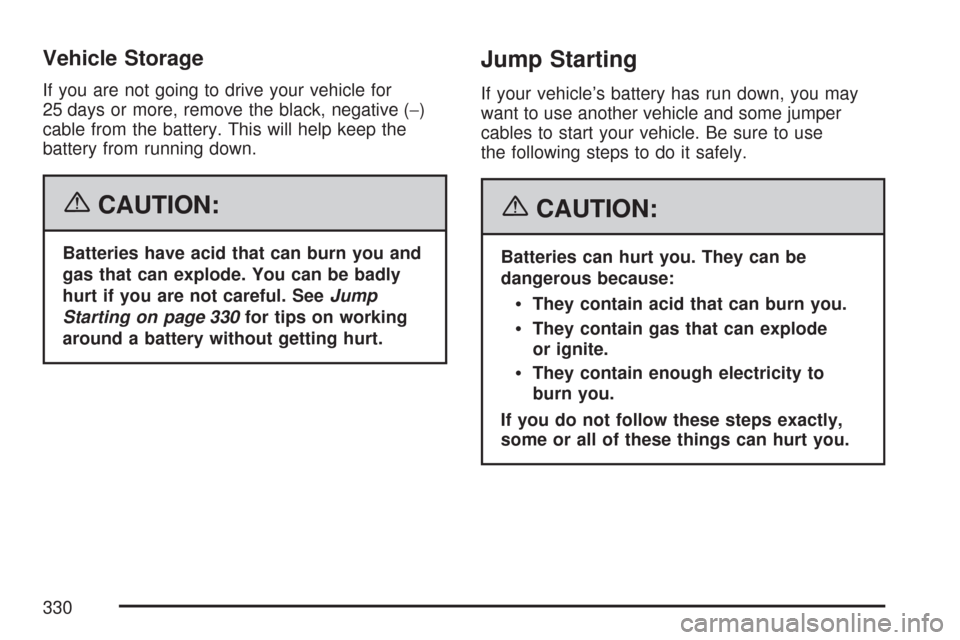
Vehicle Storage
If you are not going to drive your vehicle for
25 days or more, remove the black, negative (−)
cable from the battery. This will help keep the
battery from running down.
{CAUTION:
Batteries have acid that can burn you and
gas that can explode. You can be badly
hurt if you are not careful. SeeJump
Starting on page 330for tips on working
around a battery without getting hurt.
Jump Starting
If your vehicle’s battery has run down, you may
want to use another vehicle and some jumper
cables to start your vehicle. Be sure to use
the following steps to do it safely.
{CAUTION:
Batteries can hurt you. They can be
dangerous because:
They contain acid that can burn you.
They contain gas that can explode
or ignite.
They contain enough electricity to
burn you.
If you do not follow these steps exactly,
some or all of these things can hurt you.
330
Page 331 of 458
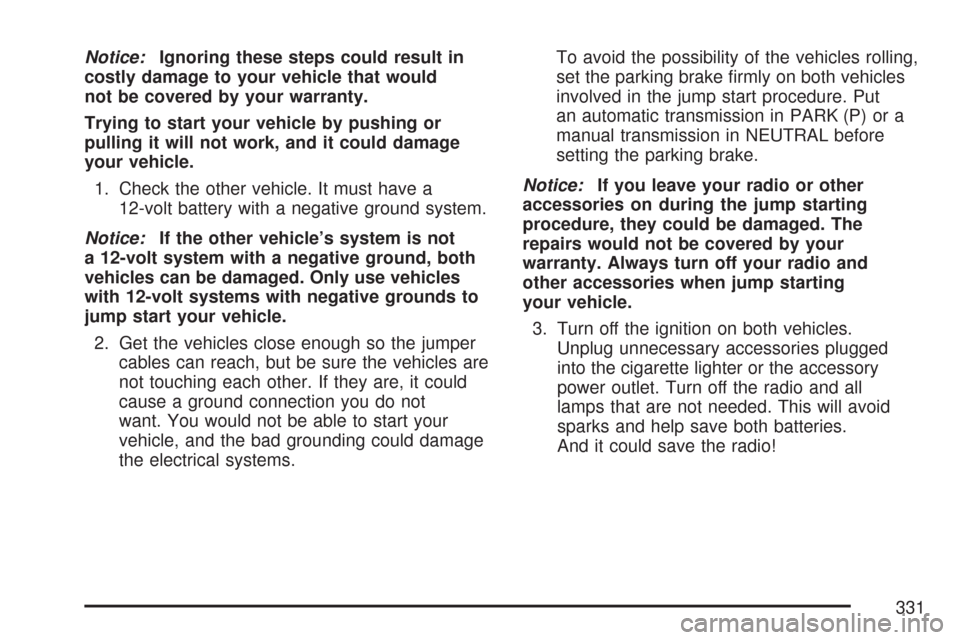
Notice:Ignoring these steps could result in
costly damage to your vehicle that would
not be covered by your warranty.
Trying to start your vehicle by pushing or
pulling it will not work, and it could damage
your vehicle.
1. Check the other vehicle. It must have a
12-volt battery with a negative ground system.
Notice:If the other vehicle’s system is not
a 12-volt system with a negative ground, both
vehicles can be damaged. Only use vehicles
with 12-volt systems with negative grounds to
jump start your vehicle.
2. Get the vehicles close enough so the jumper
cables can reach, but be sure the vehicles are
not touching each other. If they are, it could
cause a ground connection you do not
want. You would not be able to start your
vehicle, and the bad grounding could damage
the electrical systems.To avoid the possibility of the vehicles rolling,
set the parking brake firmly on both vehicles
involved in the jump start procedure. Put
an automatic transmission in PARK (P) or a
manual transmission in NEUTRAL before
setting the parking brake.
Notice:If you leave your radio or other
accessories on during the jump starting
procedure, they could be damaged. The
repairs would not be covered by your
warranty. Always turn off your radio and
other accessories when jump starting
your vehicle.
3. Turn off the ignition on both vehicles.
Unplug unnecessary accessories plugged
into the cigarette lighter or the accessory
power outlet. Turn off the radio and all
lamps that are not needed. This will avoid
sparks and help save both batteries.
And it could save the radio!
331
Page 332 of 458
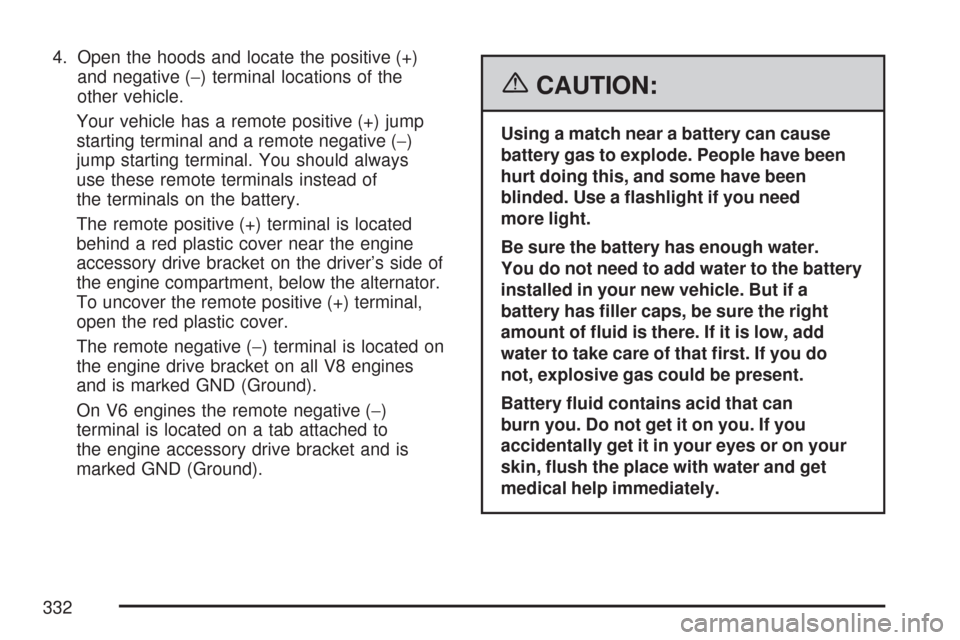
4. Open the hoods and locate the positive (+)
and negative (−) terminal locations of the
other vehicle.
Your vehicle has a remote positive (+) jump
starting terminal and a remote negative (−)
jump starting terminal. You should always
use these remote terminals instead of
the terminals on the battery.
The remote positive (+) terminal is located
behind a red plastic cover near the engine
accessory drive bracket on the driver’s side of
the engine compartment, below the alternator.
To uncover the remote positive (+) terminal,
open the red plastic cover.
The remote negative (−) terminal is located on
the engine drive bracket on all V8 engines
and is marked GND (Ground).
On V6 engines the remote negative (−)
terminal is located on a tab attached to
the engine accessory drive bracket and is
marked GND (Ground).
{CAUTION:
Using a match near a battery can cause
battery gas to explode. People have been
hurt doing this, and some have been
blinded. Use a �ashlight if you need
more light.
Be sure the battery has enough water.
You do not need to add water to the battery
installed in your new vehicle. But if a
battery has �ller caps, be sure the right
amount of �uid is there. If it is low, add
water to take care of that �rst. If you do
not, explosive gas could be present.
Battery �uid contains acid that can
burn you. Do not get it on you. If you
accidentally get it in your eyes or on your
skin, �ush the place with water and get
medical help immediately.
332
Page 334 of 458
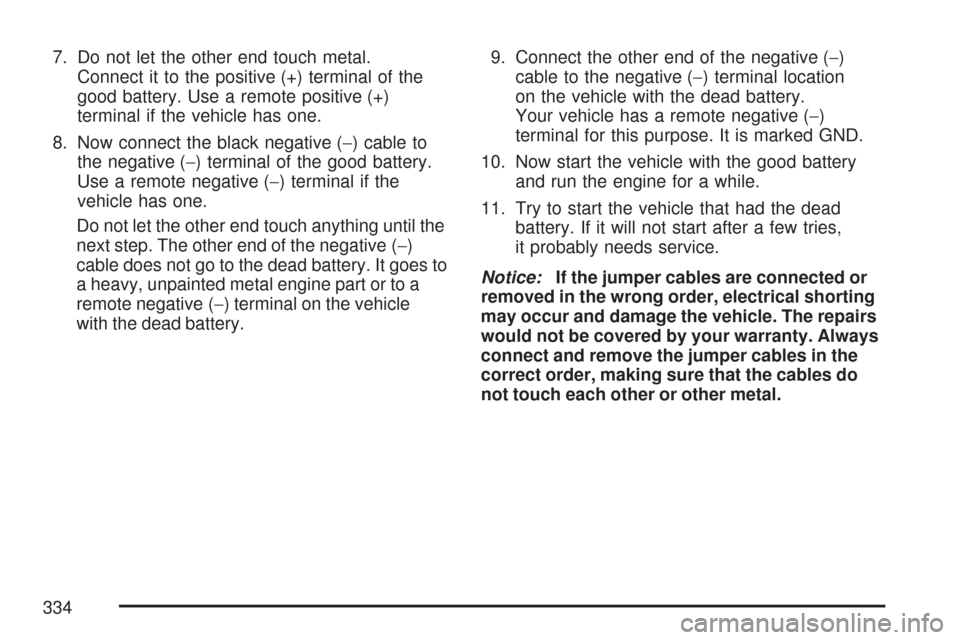
7. Do not let the other end touch metal.
Connect it to the positive (+) terminal of the
good battery. Use a remote positive (+)
terminal if the vehicle has one.
8. Now connect the black negative (−) cable to
the negative (−) terminal of the good battery.
Use a remote negative (−) terminal if the
vehicle has one.
Do not let the other end touch anything until the
next step. The other end of the negative (−)
cable does not go to the dead battery. It goes to
a heavy, unpainted metal engine part or to a
remote negative (−) terminal on the vehicle
with the dead battery.9. Connect the other end of the negative (−)
cable to the negative (−) terminal location
on the vehicle with the dead battery.
Your vehicle has a remote negative (−)
terminal for this purpose. It is marked GND.
10. Now start the vehicle with the good battery
and run the engine for a while.
11. Try to start the vehicle that had the dead
battery. If it will not start after a few tries,
it probably needs service.
Notice:If the jumper cables are connected or
removed in the wrong order, electrical shorting
may occur and damage the vehicle. The repairs
would not be covered by your warranty. Always
connect and remove the jumper cables in the
correct order, making sure that the cables do
not touch each other or other metal.
334
Page 431 of 458
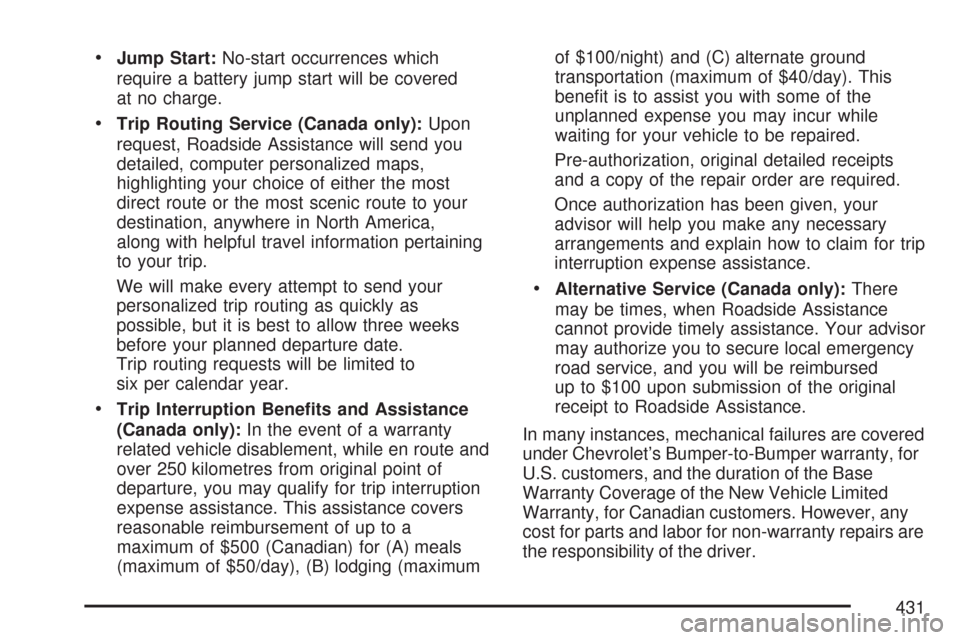
•Jump Start:No-start occurrences which
require a battery jump start will be covered
at no charge.
•Trip Routing Service (Canada only):Upon
request, Roadside Assistance will send you
detailed, computer personalized maps,
highlighting your choice of either the most
direct route or the most scenic route to your
destination, anywhere in North America,
along with helpful travel information pertaining
to your trip.
We will make every attempt to send your
personalized trip routing as quickly as
possible, but it is best to allow three weeks
before your planned departure date.
Trip routing requests will be limited to
six per calendar year.
•Trip Interruption Bene�ts and Assistance
(Canada only):In the event of a warranty
related vehicle disablement, while en route and
over 250 kilometres from original point of
departure, you may qualify for trip interruption
expense assistance. This assistance covers
reasonable reimbursement of up to a
maximum of $500 (Canadian) for (A) meals
(maximum of $50/day), (B) lodging (maximumof $100/night) and (C) alternate ground
transportation (maximum of $40/day). This
benefit is to assist you with some of the
unplanned expense you may incur while
waiting for your vehicle to be repaired.
Pre-authorization, original detailed receipts
and a copy of the repair order are required.
Once authorization has been given, your
advisor will help you make any necessary
arrangements and explain how to claim for trip
interruption expense assistance.
•Alternative Service (Canada only):There
may be times, when Roadside Assistance
cannot provide timely assistance. Your advisor
may authorize you to secure local emergency
road service, and you will be reimbursed
up to $100 upon submission of the original
receipt to Roadside Assistance.
In many instances, mechanical failures are covered
under Chevrolet’s Bumper-to-Bumper warranty, for
U.S. customers, and the duration of the Base
Warranty Coverage of the New Vehicle Limited
Warranty, for Canadian customers. However, any
cost for parts and labor for non-warranty repairs are
the responsibility of the driver.
431
Page 451 of 458

Headlamps (cont.)
Halogen Bulbs......................................... 340
High/Low Beam Changer......................... 149
On Reminder........................................... 156
Heater......................................................... 160
Highbeam On Light..................................... 185
Highway Hypnosis....................................... 253
Hill and Mountain Roads............................. 254
Hood
Checking Things Under............................ 300
Release................................................... 300
Horn............................................................ 146
How to Use This Manual................................ 4
How to Wear Safety Belts Properly............... 22
I
Ignition Positions......................................... 120
Infants and Young Children, Restraints.......... 44
Inflation - Tire Pressure............................... 354
Instrument Panel
Overview.................................................. 144
Instrument Panel (I/P)
Brightness................................................ 157
Cluster..................................................... 167
J
Jump Starting.............................................. 330
K
Keyless Entry System................................. 104
Keys........................................................... 102
L
Labeling, Tire Sidewall................................. 347
Lamps
Dome....................................................... 157
Dome Lamp Override............................... 157
Reading................................................... 158
LATCH System
Child Restraints......................................... 54
Light
Airbag Off................................................ 170
Airbag Readiness..................................... 169
Anti-Lock Brake System Warning............. 176
Brake System Warning............................. 175
Change Engine Oil................................... 183
Charging System..................................... 174
Check Gages Warning............................. 185
Cruise Control.......................................... 184
451